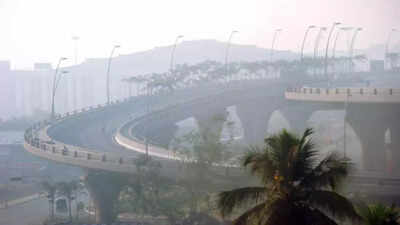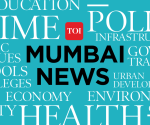Even in Summer, toxic PM2.5 in air exceeded WHO & national standards in Mumbai | Mumbai News – Times of India


MUMBAI: Heatwaves and extremely high temperatures over the past few months have been a cause of concern across the country. However, Climate Trends, a platform engaged in environmental research, studied the worrying connection between meteorology and air quality in five big Indian cities including Mumbai. Though summer in India is considered to have favorable meteorological conditions for cleaner air as compared to the winter months, it has been observed in the research that PM2.5 concentrations across the studied cities including Mumbai consistently exceeded the WHO as well as national standards on some days in April and May from 2022 to 2024.
The data also indicates that summer conditions can lead to occasional spikes in PM2.5 due to the formation of secondary pollutants like ground-level ozone and dust storms, it adds. Ground-level ozone is a colorless and highly irritating gas that forms just above the earth’s surface. It is called a “secondary” pollutant because it is produced when two primary pollutants react in sunlight and stagnant air. These two primary pollutants are nitrogen oxides (NOx) and volatile organic compounds (VOCs).
“Based on the data in Mumbai, in April 2022, there were noticeable spikes in PM2.5 concentrations corresponding with higher temperatures. For instance, on April 21, 2022, PM2.5 levels reached 58.41 µg/m3 when the temperature was 31.05°C. Similarly, on April 22, 2022, PM2.5 levels rose to 65.74 µg/m3 alongside a temperature of 30.98°C. These instances suggest that higher temperatures might contribute to increased PM2.5 concentrations, possibly due to enhanced chemical reactions in the atmosphere or increased emissions of pollutants,” stated the study. Climate Trends is a research-based consulting and capacity-building initiative in the field of the environment.
The national standards suggest that the annual average concentration of PM2.5 in the air should not exceed 40 µg/m3, while the same for 24 hours should not cross the 60 µg/m3 limit. As per WHO guidelines, the annual average concentrations of PM2.5 should not exceed 5 µg/m3, while 24-hour average exposures should not exceed 15 µg/m3 on more than 3-4 days per year. As per the study, it is clear that Mumbai has not only left the WHO standards far behind but has also touched or crossed the national standards on many occasions over the last three years. It may be mentioned here that the higher concentration of toxic PM2.5 in the air is considered as the worst air quality since these particles, after being absorbed through the nose, can reach the bloodstream of a human being and are carcinogenic in nature.
A similar trend is observed in April 2023 and 2024 in Mumbai. On April 18, 2023, PM2.5 levels were at 40.49 µg/m3 with a temperature of 30.79°C, and on April 19, 2023, they peaked at 49.21 µg/m3 with a temperature of 31.09°C. In April 2024, notable peaks in PM2.5 levels also coincided with high temperatures, such as on April 16, 2024, where PM2.5 reached 47.54 µg/m3 and the temperature was 31.11°C. These recurring patterns across different years emphasize a consistent correlation where higher temperatures tend to coincide with elevated PM2.5 levels. This relationship highlights the importance of monitoring air quality, especially during warmer periods, to mitigate the adverse effects of air pollution on health and the environment, the study suggested.
The PM2.5 data for the selected cities were obtained from the Central Pollution Control Board (CPCB) website (https://app.cpcbccr.com). Dr. Palak Balyan, Research Lead, Climate Trends said, “While we are alarmed by the record-breaking levels of air pollution in the winter months, the pollution in the summer months could harm us in different ways. Understanding the interplay between PM2.5 levels and temperature is crucial for developing effective air quality management and public health protection strategies.”
Harshal Salve, Additional Professor, Community Medicine, AIIMS New Delhi, said, “High levels of pollutants such as PM2.5 and PM10 can exacerbate respiratory conditions, trigger asthma attacks, and lead to cardiovascular problems. We already see vulnerable groups, including children and the elderly, exhibiting heightened signs of these during the winter months; its burden during summer further adds to the risk. Heatwaves increase dust pollution, adding to the double whammy.”














